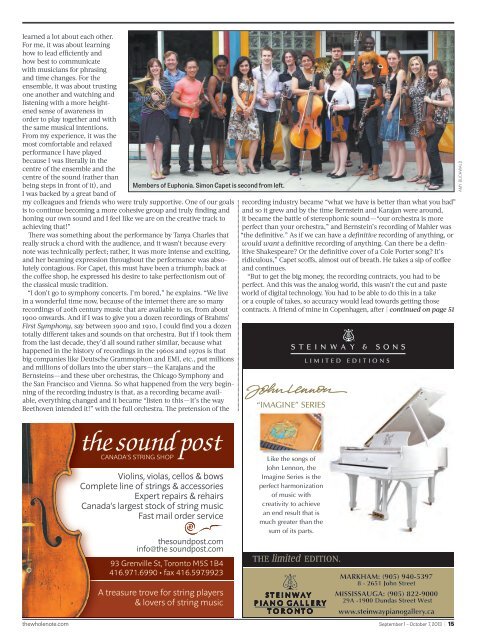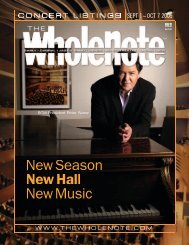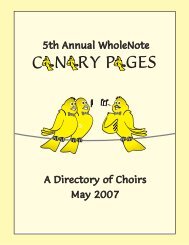Beat by Beat | In the ClubsBreaking Barrierswith Simon CapetOri DaganHANNAFORD STREET SILVER BAND30th Anniversary2013/2014SUBSCRIBESubscription packages / individual tickets available via:www.stlc.com27 Front Street East, Toronto, ON M5E 1B4Box Office: 416.366.7723 or 1.800.708.6754hssb.caOver a cup of joe at his favourite neighbourhood espressobar, English conductor Simon Capet spills the beans. We’rehere to talk about the inspirations behind his buzzed-aboutprojects: the weekly Classical Social sessions at Fionn MacCool’s andthe monthly Monday night concerts at Lula Lounge with his excitingnew group, Euphonia. A bit of chit-chat on how his surname is Frenchin origin — pronounced Ka-pay — and his recent relocation to Torontoafter 15 years as a Vancouverite, and it isn’t long before we get down tothe nitty gritty: what he feels is wrong with classical music performancethese days and how to make it right.“I often make the analogy between music and food; one sustainsthe body, the other sustains the soul,” he says emphatically. “I feellike if you look back at how food was in the 1970s it was either overcookedbeef and vegetables or it was pompous French cuisine, andclassical music got itself stuck into the pompous French cuisine mold.And actually my greatest inspirations for what I am doing are culinaryones — the Jamie Olivers and the Anthony Bourdains or before that theRaymond Blancs — these men actually managed to break down thosebarriers and now people of all social backgrounds are experimentingwith different kinds of food. That’s what I want to see happen withclassical music.”<strong>The</strong> weekly Classical Social series at Fionn MacCool’s (181 UniversityAve.) is a case in point. <strong>The</strong>se Sunday evenings are similar to jazz jamsessions, with the main difference being that the music is not improvised,but sight-read.“One of the things that is wonderful about Classical Social is that weare performing some of these great arrangements that have literallybeen sitting in the U of T library for decades. Things like the arrangementof Haydn’s Symphony No.6 by Salomon — the entrepreneur whobrought Haydn to London in the 18th century. Back then, this wasthe equivalent of taking home a CD from a gig! <strong>The</strong> way that it usedto work with publishers in those days, they made no money from thesale of their symphonies, other than an initial commission; the waythey made money was by writing arrangements of their symphoniesfor all sorts of things. Beethoven arranged his symphonies formandolin and piano, and those he sold and made money from. Andthis was true up until the 20th century.”Who knew that Bach, Beethoven and Brahms would go so wellwith a pint? Bringing this music to the bar has proven to be a brilliantidea. Not only for the musicians, who rarely get to perform injeans and sandals, but also for audiences who in some cases stumbleupon this music for the first time. In many cases customer from FionnMacCool’s end up in the audience at Lula Lounge, where Capet’s16-piece ensemble, Euphonia, appears every month.I attended the August concert, and was surprised to find the groupsituated on the dance floor, rather than the stage; another surprisewas the invitation to “keep your cell phone on” during the performance,encouraging the audience to tweet throughout the evening. <strong>The</strong>orchestra members — a diverse group of women and men — wore avariety of vibrant colours. As for the music, Capet’s selections for theevening functioned as sweet and salty flavour combinations that werejust right, from the obscure to the familiar: Paisiello, Salieri, Mozartand Haydn. In addition to the conductor, if there was another star thatnight it was exuberant Tanya Charles on violin, the featured soloist onMozart’s Violin Concerto No.4 in D Major K218. To keep things innovative,Capet had Charles conduct that piece as well as present her ownoriginal, playful cadenzas. Reflecting on the experience, Charles hadthis to say:“It was a challenge for us all, but as an ensemble, I feel that we14 | September 1 – October 7, 2013 thewholenote.com
learned a lot about each other.For me, it was about learninghow to lead efficiently andhow best to communicatewith musicians for phrasingand time changes. For theensemble, it was about trustingone another and watching andlistening with a more heightenedsense of awareness inorder to play together and withthe same musical intentions.From my experience, it was themost comfortable and relaxedperformance I have playedbecause I was literally in thecentre of the ensemble and thecentre of the sound (rather thanbeing steps in front of it), andI was backed by a great band ofmy colleagues and friends who were truly supportive. One of our goalsis to continue becoming a more cohesive group and truly finding andhoning our own sound and I feel like we are on the creative track toachieving that!”<strong>The</strong>re was something about the performance by Tanya Charles thatreally struck a chord with the audience, and it wasn’t because everynote was technically perfect; rather, it was more intense and exciting,and her beaming expression throughout the performance was absolutelycontagious. For Capet, this must have been a triumph; back atthe coffee shop, he expressed his desire to take perfectionism out ofthe classical music tradition.“I don’t go to symphony concerts. I’m bored,” he explains. “We livein a wonderful time now, because of the internet there are so manyrecordings of 20th century music that are available to us, from about1900 onwards. And if I was to give you a dozen recordings of Brahms’First Symphony, say between 1900 and 1910, I could find you a dozentotally different takes and sounds on that orchestra. But if I took themfrom the last decade, they’d all sound rather similar, because whathappened in the history of recordings in the 1960s and 1970s is thatbig companies like Deutsche Grammophon and EMI, etc., put millionsand millions of dollars into the uber stars — the Karajans and theBernsteins — and these uber orchestras, the Chicago Symphony andthe San Francisco and Vienna. So what happened from the very beginningof the recording industry is that, as a recording became available,everything changed and it became “listen to this — it’s the wayBeethoven intended it!” with the full orchestra. <strong>The</strong> pretension of theMembers of Euphonia. Simon Capet is second from left.recording industry became “what we have is better than what you had”and so it grew and by the time Bernstein and Karajan were around,it became the battle of stereophonic sound — “our orchestra is moreperfect than your orchestra,” and Bernstein’s recording of Mahler was“the definitive.” As if we can have a definitive recording of anything, orwould want a definitive recording of anything. Can there be a definitiveShakespeare? Or the definitive cover of a Cole Porter song? It’sridiculous,” Capet scoffs, almost out of breath. He takes a sip of coffeeand continues.“But to get the big money, the recording contracts, you had to beperfect. And this was the analog world, this wasn’t the cut and pasteworld of digital technology. You had to be able to do this in a takeor a couple of takes, so accuracy would lead towards getting thosecontracts. A friend of mine in Copenhagen, after | continued on page 51Amy BuchwaldViolins, violas, cellos & bowsComplete line of strings & accessoriesExpert repairs & rehairsCanada’s largest stock of string musicFast mail order servicethesoundpost.cominfo@the soundpost.com93 Grenville St, Toronto M5S 1B4416.971.6990 • fax 416.597.9923A treasure trove for string players& lovers of string musicthewholenote.com September 1 – October 7, 2013 | 15
















